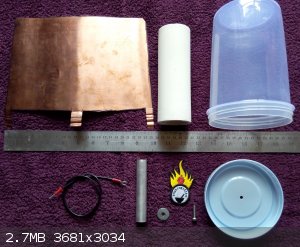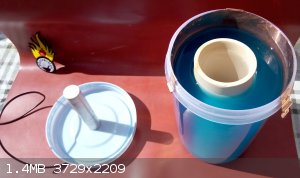AngelEyes
Hazard to Others
  
Posts: 187
Registered: 24-1-2003
Location: South of England
Member Is Offline
Mood: Better than it used to be.
|
|
One-shot electrochemical cell
Afternoon all,
For various reasons, I want to make an electrochemical cell...but one that doesn't have to be rechargeable because it'll only get used once. Instead,
it has to use non-toxic, non-flammable, non-oxidising and non-corrosive materials. But still give a decent voltage per cell.
After a little preliminary searching for standard electrode potentials, mostly on wikipedia, the following seems to fit the bill:
Half cell 1:
Lithium anode(s) in a solution of lithium sulphate.
Half cell 2:
Copper cathode(s) in a solution of copper sulphate
Li2 -> Li2+ = -3.04
Cu2+ -> Cu = +0.223
...giving a potential of 3.263V per whole cell.
Is that right?
Is there any other pair of half cells that could give better than 3.2V per cell?
Is there any way to work out the amperage / wattage of a cell like this?
Finally, am I correct in thinking that a more concentrated solution, or more surface area on the electrode(s), would yield a higher voltage?
Cheers all
Angel
\'Silk and satin, leather and lace...black panties with an Angel\'s face\'
|
|
|
unionised
International Hazard
    
Posts: 5102
Registered: 1-11-2003
Location: UK
Member Is Offline
Mood: No Mood
|
|
Lithium salts are toxic.
More importantly, the lithium metal will react with the water.
There's a reason why they use weird solvents like propylene carbonate.
So the cell would just dissolve into a corrosive mess.
|
|
|
brubei
Hazard to Others
  
Posts: 187
Registered: 8-3-2015
Location: France
Member Is Offline
Mood: No Mood
|
|
Lithium carbonate solution state in a E-pH diagram

Minerals Engineering (110) 2017, Pages 104-121
https://www.sciencedirect.com
Blue dots show water stability, below this line LiH react with water to form Li+
, OH- and H2. Your solution will turn more basic with the LiOH production until saturation and passivisation of lithium.
[Edited on 30-3-2022 by brubei]
I'm French so excuse my language
|
|
|
AngelEyes
Hazard to Others
  
Posts: 187
Registered: 24-1-2003
Location: South of England
Member Is Offline
Mood: Better than it used to be.
|
|
Didn't think it was that bad, as long as you don't quaff it down by the mugful that is.
Having said that though, perhaps Mg Sulphate would be a better choice.
-2.7V potential for Mg, so not too much of a loss compared to Li, and cheaper / easier to work with too. Plus less toxicity.
So I'd be looking at:
Mg -> Mg2+ = -2.7
Cu2+ -> Cu = +0.223
...giving a potential of 2.923V per whole cell.
Cheers
Angel
\'Silk and satin, leather and lace...black panties with an Angel\'s face\'
|
|
|
Sulaiman
International Hazard
    
Posts: 3554
Registered: 8-2-2015
Location: 3rd rock from the sun
Member Is Offline
|
|
my first Mg/Cu cell (7 years ago)
 
18mm dia. 100mm long Magnesium rod anode, magnesium sulphate, porous pot, copper sulphate, copper foil cathode, plastic tub
I made two near identical cells for comparative tests.
Did it work ? yes
Did it give expected voltage ? no
With saturated solutions of magnesium and copper sulphates I got about 1.91v
Each diluted to c1M gave c2v11 at 8 oC
[Edited on 1-4-2022 by Sulaiman]
CAUTION : Hobby Chemist, not Professional or even Amateur
|
|
|
AngelEyes
Hazard to Others
  
Posts: 187
Registered: 24-1-2003
Location: South of England
Member Is Offline
Mood: Better than it used to be.
|
|
Thanks for posting that Sulaiman, much appreciated.
\'Silk and satin, leather and lace...black panties with an Angel\'s face\'
|
|
|
Sulaiman
International Hazard
    
Posts: 3554
Registered: 8-2-2015
Location: 3rd rock from the sun
Member Is Offline
|
|
The Mg/Cu cells were interesting but not a good example to follow,
- the distance that current/ions have to flow through the electrolyte is too long
... which makes the internal resistance much higher than optimal
- the porous pot also increases internal resistance
- I think that dilute sulphuric acid instead of magnesium sulphate solution would work better
I think that two good starting points are;
gravity cell https://en.wikipedia.org/wiki/History_of_the_battery (Not tried myself)
and
buy and dissect a 6v lantern/lamp/torch battery to get 4x carbon rod, 4x quite pure zinc cups, and more ...
Also, it helps if you remember which is anode and which is cathode 
[Edited on 5-4-2022 by Sulaiman]
CAUTION : Hobby Chemist, not Professional or even Amateur
|
|
|
unionised
International Hazard
    
Posts: 5102
Registered: 1-11-2003
Location: UK
Member Is Offline
Mood: No Mood
|
|
Quote: Originally posted by Sulaiman  |
- I think that dilute sulphuric acid instead of magnesium sulphate solution would work better
[Edited on 5-4-2022 by Sulaiman] |
have you seen how fast dilute acid attacks magnesium?
|
|
|
Sulaiman
International Hazard
    
Posts: 3554
Registered: 8-2-2015
Location: 3rd rock from the sun
Member Is Offline
|
|
After I've moved, unpacked and settled down I intend to re-visit these cells,
(hopefully about a year from now)
Meanwhile,
I think that an electrically isolated piece of pure magnesium, zinc etc. will be initially attacked by the acid until the volage between the metal and
liquid is enough to stop the reaction.
(makes me think of how slowly a tin ingot dissolves in HCl, 'coulombic explosion' of Na in water, and similar situations)
(monitoring of electrical potentials in such situations has just become a project for me... maybe... later 
Note : the above seemed logical to me when I wrote it, and it still does,
but a quick reality check confused me...
Magnesium ribbon in 3.4M sulphuric acid (a fraction range from an earlier distillation) in a borosilicate beaker
Dissolves quickly with significant effervescence.
Separate pieces of ribbon appear to repel each other at close range,
but that may just be due to the effervescence.
EDIT : Mg ribbon in conc. sulphuric acid dissolves slowly with a little effervescence,
in c2% acid the ribbon dissolved quickly with effervescence.
So
I guess dilite sulphuric acid would NOT be a good replacement for magnesium sulphate solution 
Sorry to AngelEyes and thanks to unionised !
P. S. If you do buy and dissect a lantern battery,
wear gloves and be prepared to deal with lots of carbon/manganese dioxide powder - which stains anything it touches.
Not particularly dangerous but potentially very messy.
Update : after being in the conc. sulphuric acid for some time (>30min.) the remaining, very shiny, magnesium ribbon is floating on the surface
with some very slow growing bubbles attached, almost ceased reacting.
[Edited on 5-4-2022 by Sulaiman]
CAUTION : Hobby Chemist, not Professional or even Amateur
|
|
|
Mateo_swe
National Hazard
   
Posts: 501
Registered: 24-8-2019
Location: Within EU
Member Is Offline
|
|
Doesn't the intended use of the cell highly affect how you construct it and materials/chemicals used?
What are the intended use for the cell?
|
|
|